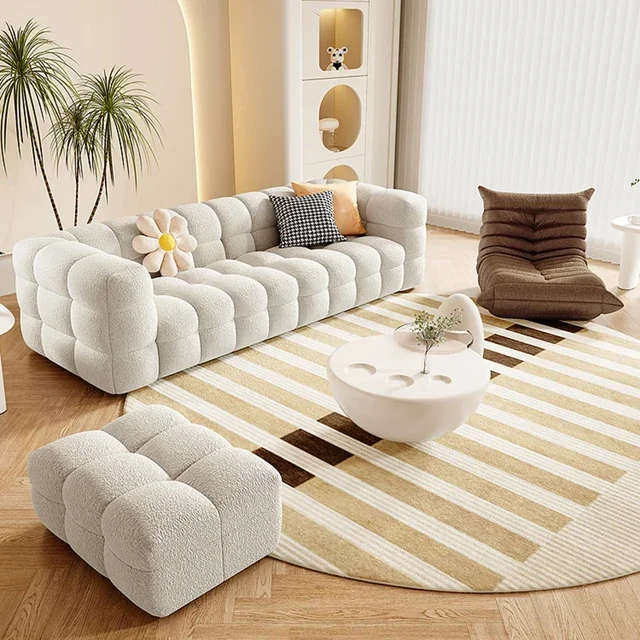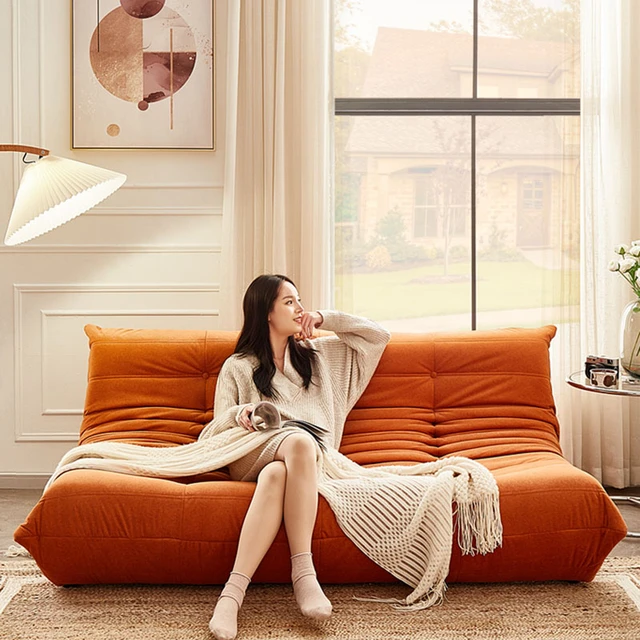 Introduction:
Introduction:
Measuring a sofa is essential when buying new furniture or rearranging your living space. Accurate measurements can help you ensure that the sofa fits comfortably in your room and aligns with your design vision. In this comprehensive guide, we will explore the step-by-step process of measuring a sofa, including the key dimensions to consider and tips for accuracy.
 Here are some common types of sofas:
Here are some common types of sofas:
There are various types of sofas available, each with its own unique features and design elements. Here are some common types of sofas:
Sectional Sofa: Sectionals consist of multiple sections that can be arranged in different configurations. They are versatile and can be customized to fit various room sizes and layouts.
Chesterfield Sofa: Chesterfield sofas have a distinctive tufted and buttoned upholstery, along with rolled arms and a low backrest. They often exude a classic and luxurious style.
Sleeper Sofa: Also known as a sofa bed or pull-out sofa, a sleeper sofa has a hidden mattress that can be unfolded to provide additional sleeping space. They are versatile and suitable for accommodating overnight guests.
Recliner Sofa: Recliner sofas have built-in reclining mechanisms that allow the user to adjust the backrest and footrest to find a comfortable position. They are ideal for relaxation and can be manual or powered.
Loveseat: Loveseats are small-scale sofas designed to accommodate two people. They are suitable for smaller spaces or as additional seating in larger rooms.
Chaise Lounge: A chaise lounge sofa has an extended seat for reclining or resting with legs fully supported. It offers a luxurious and comfortable seating option for relaxation.
Measuring a sofa is important for several reasons:
Fit and Proportions:
By accurately measuring the dimensions of a sofa, you can ensure that it fits properly in the designated space. This helps to maintain a balanced and aesthetically pleasing appearance in the room. If a sofa is too large or too small for the space, it can disrupt the overall design and functionality of the room.
Doorways and Hallways:
Measuring the sofa is essential to determine if it can fit through doorways, hallways, and any narrow passages leading to the intended placement area. This prevents the hassle and potential damage of trying to maneuver a sofa that is too big to fit through the available openings.
Comfort and Ergonomics:
The dimensions of a sofa, such as seat depth, height, and armrest height, can greatly impact comfort and ergonomics. Measuring these dimensions helps ensure that the sofa provides a comfortable seating experience and proper support, especially for individuals with specific comfort needs or physical requirements.
Functionality and Space Planning:
Measuring the sofa allows for efficient space planning and furniture arrangement. It helps determine how much space the sofa will occupy, leaving room for other furniture, walkways, and functional elements within the room.
Online Purchases:
When purchasing a sofa online, accurate measurements are crucial for making an informed decision. Knowing the size of the sofa allows you to compare it with the available space in your home and ensure it will fit properly before making a purchase.
Overall, measuring a sofa is essential to ensure a proper fit, functionality, comfort, and to avoid any complications or regrets in the future. It helps create a harmonious and well-planned living space that meets both aesthetic and practical requirements.
 Key Dimensions to Measure
Key Dimensions to Measure
Overall Length:
Measure the length of the sofa from the outer edge of one arm to the outer edge of the opposite arm.
This measurement will give you the overall length of the sofa.
Seat Length:
Measure the length of the seat cushion from the back of the sofa to the front edge.
This dimension is helpful in determining the seating space available.
Overall Height:
Measure the height of the sofa from the floor to the highest point, which may be the top of the backrest or the armrests.
This measurement is crucial for ensuring the sofa fits comfortably within the height of the room or under low ceilings.
Measure the depth of the seat cushion from the front edge to the backrest.
This dimension determines the amount of seating space available and influences comfort.
Overall Depth:
Measure the overall depth of the sofa from the outer edge of one arm to the outer edge of the backrest.
This dimension is important for determining how far the sofa protrudes into the room.
 Step-by-Step Process of Measuring a Sofa
Step-by-Step Process of Measuring a Sofa
Clear the Area:
Clear any obstructions or furniture around the sofa, allowing easy access for measuring.
Prepare the Measuring Tools:
Use a measuring tape or a retractable metal tape measure for accuracy.
Measure the Overall Length:
Position the tape measure at the outer edge of one armrest and extend it across to the outer edge of the opposite armrest.
Note down the measurement.
Measure the Seat Length:
Place the tape measure at the back of the sofa and extend it to the front edge of the seat cushion.
Record the measurement.
Measure the Overall Height:
Position the tape measure at the floor and extend it to the highest point of the sofa, whether it is the backrest or armrests.
Take note of the measurement.
Measure the Seat Depth:
Place the tape measure at the front edge of the seat cushion and extend it to the backrest.
Record the measurement.
Measure the Overall Depth:
Position the tape measure at the outer edge of one armrest and extend it to the furthest point of the backrest.
Take note of the measurement.
Tips for Accurate Measurement
Measure Twice:
To ensure accuracy, measure each dimension twice and compare the results.
Check Clearance:
Consider the size of your doorways, hallways, and any tight spaces the sofa will need to navigate during delivery.
Check that the measurements allow for easy entry and placement of the sofa in your desired location.
Account for Skirt or Legs:
If your sofa has a skirt or visible legs, be aware that they may add to the overall height or depth of the sofa.
Take these features into account when measuring and considering the space needed.
Consider Reclining or Sleeper Sofas:
If your sofa has reclining or sleeper functionality, ensure you measure the space needed when fully extended.
 Conclusion:
Conclusion:
Measuring a sofa accurately is key to ensuring it fits well in your living space and meets your design requirements. By considering the overall length, seat length, overall height, seat depth, and overall depth, you can select a sofa that complements your room’s size and style. By following the step-by-step process outlined in this guide and incorporating tips for accuracy, you can confidently measure a sofa and make informed decisions when purchasing new furniture or rearranging your living space.

